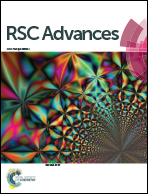Single crystalline magnetite, maghemite, and hematite nanoparticles with rich coercivity†
Abstract
One-pot synthesis of amorphous iron oxide nanoparticles with two different dimensions (<5 nm and 60 nm) has been achieved using the reverse micelle method, with <5 nm nanoparticles separated from the stable colloid by exploiting their magnetic behaviour. The transformation of the as-prepared amorphous powders into Fe3O4 and Fe2O3 phases (γ and α) is achieved by carrying out controlled annealing at elevated temperatures under different optimized conditions. The as-prepared samples resulting from micellar synthesis and the corresponding annealed ones are thoroughly characterized by powder X-ray diffraction, transmission electron microscopy (TEM), and by Raman and X-ray photoelectron spectroscopies. Expectedly, the magnetic characteristics of Fe3O4 and Fe2O3 phase (γ and α) nanoparticles are found to have strong dependence on their phase, dimension, and morphology. The coercivity of Fe3O4 and Fe2O3 (γ and α) nanoparticles is reasonably high, even though high resolution TEM studies bring out that these nanoparticles are single crystalline. This is in contrast with previous reports wherein poly-crystallinity of iron oxides nanoparticles has been regarded as a prerequisite for high coercivity.


 Please wait while we load your content...
Please wait while we load your content...